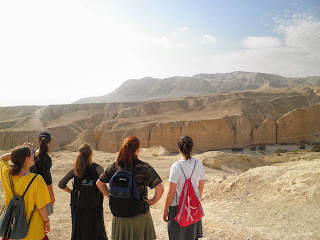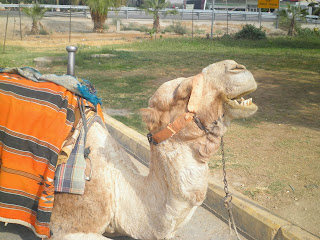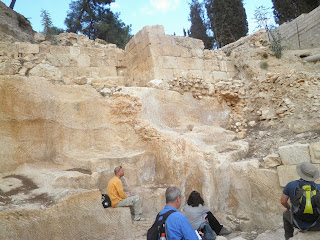 |
| Surveying the Nahal at the beginning of the hike |
Rain. It has been the talk of the town here in Jerusalem. Until last week many Rabbis from across the religious spectrum were calling for their constituents to pray for rain in what was being called an abnormally dry winter.
But on Tuesday night of Chanukah there were some students at Midreshet Emunah v'Omanut hoping the rain would hold out just a few hours longer. Planned weeks before, I was set to guide these girls on a fun hike to Nahal Og on Wednesday during their Chanukah break. We had our water bottles, hats, and sunscreen ready, the only obstacle was a possible rainy forecast.
Now don't get me wrong, these girls are not afraid of a little rain. Check out the video below to see what happens when it rains in or near Nahal Og. (Notice the video is taken in the same place as the picture above.)
As you can see in the clip, in a few short minutes, the entire river bed is filled with fast moving water. You no longer wonder why this usually dry valley is called a Nahal, river, in Hebrew. These sudden flash floods can be very dangerous, and it is not worth the risk of hiking in the Nahal.
So at 7am on Wednesday morning, when the girls received a text that the hike was on, there was definite excitement. We took a bus from the central bus station in Jerusalem to Almog Junction, and from there it was about a 15 minute walk to our hike through the Nahal.
 |
| Mountain goats? |
 |
| "Ain't no mountain high" |
A quick hour and a bit later, after climbing both rocks and on rungs hammered into the side of the mountains, we were rewarded with this view on the other side.
 |
| View from the other side |
 |
| Proud hikers at the end of the route. |
Proud of what we accomplished, we set back towards the bus. When we reached the junction, we stopped for a quick camel ride at the gas station-only in Israel!
 |
| Twins on a camel |
 |
| The camel has the last laugh! |
And with that, we were on our way back to Jerusalem. What a great way to spend a Chanukah day, exploring the land for which our ancestors fought so hard.
P.S Don't worry it has been raining pretty much ever since, and they are even predicting possible snow on Thursday!!



















